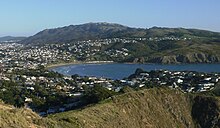Titahi Bay
| Titahi Bay | |
|---|---|
 |
|
| Basic information | |
| Local authority | Porirua City |
| Population | 7,524 |
| Surrounds | |
| North | Whitireia Park |
| East | Porirua Harbour |
| South | Takapuwahia |
| West | Tasman Sea |
Titahi Bay is a suburb of Porirua in the North Island of New Zealand. It is located at the foot of a short peninsula along the west coast of the Porirua Harbour, to the north of Porirua city centre. The suburb's population in 2006 was 7,524.
Many scenes from the Taika Waititi movie Eagle vs Shark were shot on location in Titahi Bay.
The legendary Polynesian navigator Kupe landed at Komanga Point, 3 kilometres west of Titahi Bay, leaving an anchor stone which today can be seen at the Museum of New Zealand Te Papa Tongarewa.
The area was settled by Māori for many years before the arrival of Europeans, and several pa sites are located nearby. The area was also the site of many inter-iwi conflicts, notably in the 1820s, when the area was invaded by the followers of Te Rauparaha.
The first European residents were whalers operating from Korohiwa, between Titahi Bay and Komanga Point.
During World War II, a camp housing US military personnel was built in Titahi Bay.
Titahi Bay is one kilometre from end to end and forms a bay.
Surfing is a popular activity at Titahi Bay. Titahi Bay is a beach break that can be surfed on all tides and during periods of onshore winds is generally the time to go there. The surf breaks have a vast array of size and skill sets. From the Rocks (1.5–2 m) to the famous Locals (1-2m) to the Fishermans (inside 2-3m, outside 3-5m) Mainly all on North-Westerly swell direction. This all changes when South swell arrives, different breaks from different swell direction.
A Surfing club has operated for over 30 years. Two NZ champions originate from T-Bar.
The Titahi Bay Surf Life Saving Club is located in the centre of the bay.
The boat sheds at the northern and southern ends of the beach are often featured in photographs of the area.
The fossilised remains of a forest from the era are located at Titahi Bay and form an intertidal reef. The forest was dominated by podocarps and tree-ferns and dates from the last interglacial period 150,000–70,000 years ago.
...
Wikipedia
